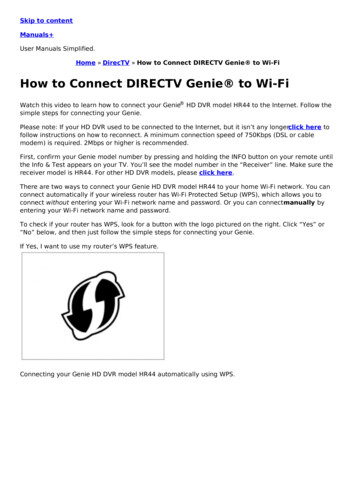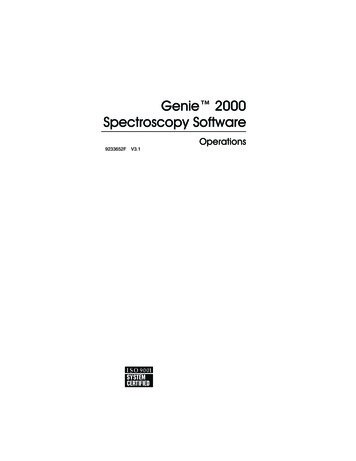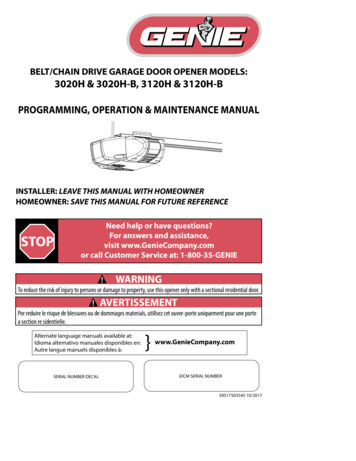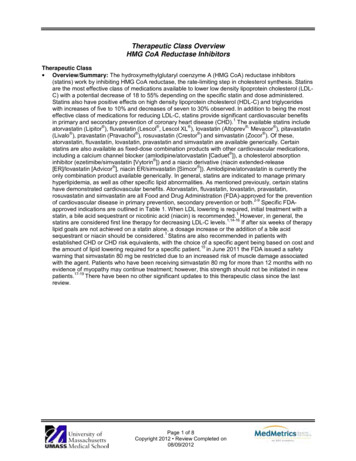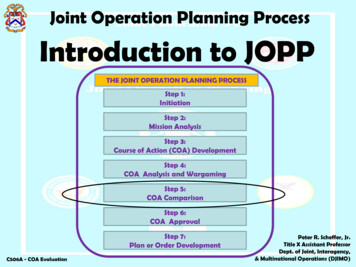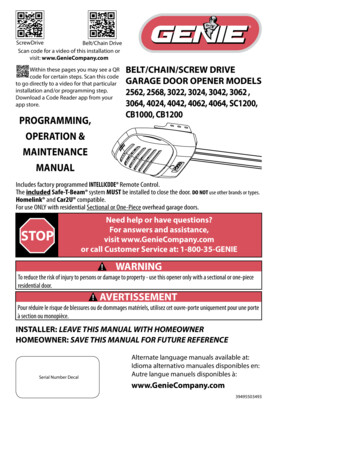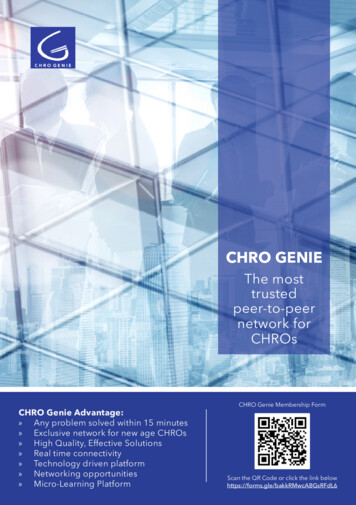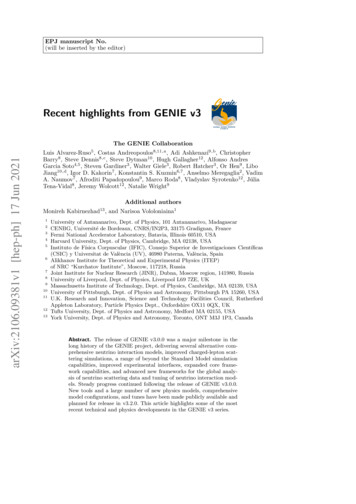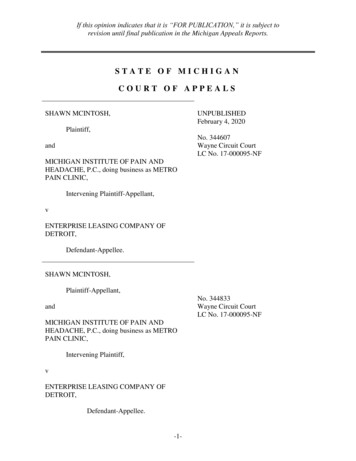
Transcription
If this opinion indicates that it is “FOR PUBLICATION,” it is subject torevision until final publication in the Michigan Appeals Reports.STATE OF MICHIGANCOURT OF APPEALSSHAWN MCINTOSH,UNPUBLISHEDFebruary 4, 2020Plaintiff,No. 344607Wayne Circuit CourtLC No. 17-000095-NFandMICHIGAN INSTITUTE OF PAIN ANDHEADACHE, P.C., doing business as METROPAIN CLINIC,Intervening Plaintiff-Appellant,vENTERPRISE LEASING COMPANY OFDETROIT,Defendant-Appellee.SHAWN MCINTOSH,Plaintiff-Appellant,No. 344833Wayne Circuit CourtLC No. 17-000095-NFandMICHIGAN INSTITUTE OF PAIN ANDHEADACHE, P.C., doing business as METROPAIN CLINIC,Intervening Plaintiff,vENTERPRISE LEASING COMPANY OFDETROIT,Defendant-Appellee.-1-
GENIE THERAPY, LLC,Plaintiff,andNo. 344882Wayne Circuit CourtLC No. 16-017213-NFSHAWN MCINTOSH,Intervening Plaintiff-Appellant,vENTERPRISE LEASING COMPANY OFDETROIT,Defendant-Appellee.Before: K. F. KELLY, P.J., and BORRELLO and SERVITTO, JJ.PER CURIAM.In Docket No. 344607 and in Docket No. 344833, the Michigan Institute of Pain andHeadache, P.C. (MIPH) (intervening plaintiff) and Shawn McIntosh (plaintiff) respectively, appealas of right the May 10, 2018 order dismissing McIntosh’s case and MIPH’s claims againstEnterprise Leasing Company of Detroit (Enterprise Leasing) pursuant to MCR 2.116(C)(10). InDocket No. 344882, McIntosh (intervening plaintiff) appeals as of right the same order, and itsholding with respect to a separate lawsuit brought by Genie Therapy, LLC (Genie Therapy); thetwo cases had been consolidated in the lower court. The trial court’s order was based on a findingof no genuine issue of material fact that McIntosh made fraudulent representations in seeking nofault personal protection insurance (PIP) benefits. This Court consolidated the appeals. ShawnMcIntosh v Enterprise Leasing Co of Detroit, unpublished order of the Court of Appeals, enteredAugust 8, 2018 (Docket Nos. 344607, 344833 and 344882). We now affirm.On January 2, 2016, McIntosh was a backseat passenger in a Nissan Versa rented to hishalf-sister, Shawntia Brown, by Enterprise Leasing. Brown was driving and was pulling into orstopped in her driveway when the Versa was struck by an unknown vehicle which then fled. TheTraffic Crash Report indicated that McIntosh was injured and taken by ambulance to Sinai GraceHospital, that the Versa’s airbags did not deploy, and that there was minor damage to the car. Aphotograph indicated that there was minor damage to the rear bumper.McIntosh claimed that the unknown car ran a stop sign and was coming toward them “fast.”He claimed that the impact on “the back door of the left side, the driver’s side on [his] side” wasso hard that “our car [spun].” He claimed that he believed he hit his head on the window and lostconsciousness “for a minute.” McIntosh alleged that he was dizzy and stayed in the hospitalovernight. He claimed that his left leg, left arm, neck, and back were injured. Thereafter, he was-2-
given shots for pain in his back, Genie Therapy provided physical therapy, and he was treated atMIPH.McIntosh claimed the following: that he was bedridden for about “four weeks” followingthe incident; that he could not lift a “gallon of milk;” and that he needed assistance with grooming,bathing, and feeding. He said that his cousin, Reneka Prince, assisted him after the collision,providing him transportation and helping him “almost 24 hours a day.” Eventually, he moved inwith his fiancée, and he claimed that she began taking care of him because he still needed “helpgetting down the stairs and sometimes getting up out the bed and [help] getting up out cars andwalking.” McIntosh allegedly told Prince and his fiancée that he would pay them for their servicesif he received any money.Brown, who was McIntosh’s half-sister, testified at deposition that the unknown car “wasnot going that fast” because, if it was, “it would have hit the car way harder than it did.” She didnot see the other car coming before the impact, and did not see it speeding or running a stop sign.According to Brown, the other car “jumped on the curb, hit the bumper and continued to go,”taking off “immediately.” Brown denied that the impact caused the car to spin in any way; shestated that it did not move upon impact. Further, Brown denied that there was any damage to therear left door area where McIntosh was sitting, noting that the impact was only to the left rearbumper. Brown stated that McIntosh never lost consciousness. She testified that he was “makingit up” with regard to his injuries when the ambulance arrived on the scene:How do I know? Because no one else was hurt. The bumper was hanging off, andhis was sitting out the car. The minute he knew the ambulance and the police weregoing to come he got back and now all of a sudden he’s sitting like this. He wasnot just doing that.***When the ambulance lights and police came coming around that corner, you cansee them before they basically really get there, he turned back in the car and thenwent from being normal to looking like he just literally got himself hit by the car.He just went into like a -- What’s up with you? It didn’t make any sense.According to Brown, the “accident” was staged by McIntosh and his cousin, Eric White,because they had been known to “run those kind of schemes.” She stated:Now, [McIntosh] is sitting there and I immediately turn to [White] and I say[White], that’s F’ed up that you did that, because they run those kind of schemes.They look for car accidents. They look for car accidents and I guess it’s like the 1800-411-Pain, because in New Jersey we don’t have that, so I know about that uphere from them; so I know they like to do those kinds of things.And I’m cursing [White] out because [White] spends a little time with me and mysister . . . , we are kind of cool. I said that’s messed up, this is a rental car, my kids.Why would you do that to me. You didn’t say anything, and not that I would havebeen with it, but you just did something to me for no reason.-3-
[White] is very apologetic and [McIntosh] is sitting there, oh, so hurt, which doesn’tmake any sense how you got that hurt when there is no bodily damage to the car.It’s to the bumper. And if you were hurt why wouldn’t the four-year old [who hadalso been in the backseat] be hurt and also why wouldn’t [White, who was also inthe back seat]? The car is a compact car.Brown asserted that after the collision McIntosh carried on with his “normal life,” and onlywore a neck brace in public. She testified that she lived with him before the accident and continuedto live with him for about one month afterward. She reported that during that time McIntosh neverreceived any attendant care or household services from Prince or anyone else.Brown continued to drive the Versa and did not report the damage to Enterprise Leasing,believing McIntosh was going to help pay to get it fixed without Enterprise Leasing finding out.Brown took the Versa to Enterprise Leasing’s office once per month for an inspection in order torenew the rental agreement. After the car was damaged, an employee there named Tina (withwhom Brown had developed a rapport) would simply look out a window to “inspect” the car, andonly the front and sides of the car were visible from the window. Tina renewed the rentalagreement in this manner for several months. Tina eventually learned from “corporate” that thecar had been in an accident and damaged, and she asked Brown to bring it in, in April 2016.On December 6, 2016, McIntosh submitted an application for personal protection insurance(PIP) benefits to Elco Insurance, which handles insurance claims for Enterprise Leasing. Heincluded forms detailing attendant care services allegedly provided by Prince for approximately4½ months for “Grooming, Toileting, Assistance w/Meds & Dressing Changes, Transfers, andSupervision.” He also submitted forms for six months of replacement household services allegedlyprovided by Prince, including cleaning, mopping, meal preparation, sweeping and vacuuming,making the bed, washing dishes, laundry, ironing, and taking out the garbage.Amanda Szyszka, the claims adjuster for Elco, questioned whether the accident occurred.She testified at deposition:The vehicle had a contract rewritten multiple times after the question of theaccident. [The Enterprise Leasing] branch saw the car with no damage; the car didnot go back to [Enterprise Leasing] until April, and that’s when it was noted that itwas hit while parked.During her investigation, Szyszka commissioned an independent medical examination ofMcIntosh. The doctor determined that his “cervical and lumbar strain/pain” had resolved, thatthere were “no objective findings” with respect to leg pain, that the treatment received was“excessive,” and that “six to eight weeks” of treatment would have been “reasonable.” Ultimately,Elco did not pay any benefits on McIntosh’s behalf.After McIntosh and his providers filed suit and the cases were consolidated, EnterpriseLeasing moved to dismiss pursuant to MCR 2.116(C)(10), asserting that the claims were all barredbecause of fraud by McIntosh and others related to the alleged accident and the claims for PIPbenefits. In response, McIntosh attested that he “did not conspire with anyone to stage thisaccident.” The trial court granted defendant’s motion, finding no genuine issue of material fact-4-
with respect to the fact that there was fraud in this case. MIPH and McIntosh now appeal as ofright.McIntosh and MIPH argue that the trial court erred in granting summary disposition todefendant pursuant to MCR 2.116(C)(10). We disagree.Summary disposition rulings are reviewed de novo. Beaudrie v Henderson, 465 Mich 124,129; 631 NW2d 308 (2001). In reviewing a motion for summary disposition under MCR2.116(C)(10), a court considers “affidavits, pleadings, depositions, admissions, and otherdocumentary evidence submitted by the parties in the light most favorable to the party opposingthe motion.” Greene v AP Prods, Ltd, 475 Mich 502, 507; 717 NW2d 855 (2006). “Summarydisposition under MCR 2.116(C)(10) is appropriately granted if there is no genuine issue regardingany material fact and the moving party is entitled to judgment as a matter of law.” Id., quotingRose v Nat’l Auction Group, 466 Mich 453, 461; 646 NW2d 455 (2002). “A genuine issue ofmaterial fact exists when the record, giving the benefit of reasonable doubt to the opposing party,leaves open an issue upon which reasonable minds might differ.” West v GMC, 469 Mich 177,183; 665 NW2d 468 (2003). A court may not make factual findings on disputed factual issues,nor make credibility determinations during a motion for summary disposition. Puetz v SpectrumHealth Hosps, 324 Mich App 51, 68-69; 919 NW2d 439 (2018). If the evidence before the courtis conflicting, summary disposition is improper. Patrick v Turkelson, 322 Mich App 595, 605606; 913 NW2d 369 (2018).McIntosh and MIPH argue that the trial court improperly assessed credibility and weighedevidence in favor of Enterprise Leasing on material issues of whether the collision was an accidentor intentional, and whether Brown’s or McIntosh’s version of the events was the correct one. Theyalso argue that there is conflicting testimony regarding material issues, that McIntosh’s claim isnot “wholly lacking” in evidence, and that a jury was therefore entitled to make thosedeterminations. McIntosh and MIPH rely, in part, on White v Taylor Distrib Co, 275 Mich App615; 739 NW2d 132 (2007), to support their positions.In White, the defendant truck driver struck the plaintiff’s car from behind. Id. at 616. Thedefendant asserted that he had blacked out, secondary to a medical problem that he thought wasunder control, and therefore was not negligent due to the application of the “sudden emergency”doctrine. The trial court granted summary disposition in his favor. This Court reversed, holdingin part:Here, defendants’ attempt to rebut the statutory presumption [ofnegligence], on which they had the burden of proof, relied on the credibility of [thedriver] with respect to his deposition testimony that he blacked out before theaccident while on the exit ramp and that he was not feeling ill when he left the restarea. These are matters that are subjective in character and primarily within theexclusive knowledge of [the driver]. It is self-evident that [the driver] would havethe motivation to give a version of events that would be favorable to him and thatwould distance him, and thereby all the defendants, from liability. A jury shouldbe permitted to assess his credibility while on the witness stand. Summarydisposition is simply not appropriate under these circumstances. [Id. at 630, italicsin original].-5-
The difference between the instant case and White is that the alleged misrepresentations inWhite were “primarily within [the truck driver’s] exclusive knowledge.” Id., at 616, 629-630. Inthe present case, on the other hand, there was an eyewitness, Brown. Brown rented the car, shedrove the car, her young kids were in the car, and she was there when the collision occurred; andshe also lived with McIntosh for a month afterward and was able to witness his post-accidentcondition. Whereas the defendant truck driver in White was the only one with knowledge of thealleged fraud, here, Brown had knowledge establishing the fact of McIntosh’s misrepresentations.Based on Brown’s observations and more, reasonable minds could not differ as to whetherMcIntosh made fraudulent representations in regard to his claims for PIP benefits.Section 4503 of the Insurance Code defines “fraudulent insurance acts,” in pertinent part,as follows:A fraudulent insurance act includes, but is not limited to, acts or omissionscommitted by any person who knowingly, and with an intent to injure, defraud, ordeceive:***(c) Presents or causes to be presented to or by any insurer, any oral or writtenstatement including computer-generated information as part of, or in support of, aclaim for payment or other benefit pursuant to an insurance policy, knowing thatthe statement contains false information concerning any fact or thing material tothe claim.(d) Assists, abets, solicits, or conspires with another to prepare or make any oral orwritten statement including computer-generated documents that is intended to bepresented to or by any insurer in connection with, or in support of, any claim forpayment or other benefit pursuant to an insurance policy, knowing that thestatement contains any false information concerning any fact or thing material tothe claim.***(i) Knowingly and willfully assists, conspires with, or urges any person tofraudulently violate [MCL 500.4501 et seq.], or any person who due to thatassistance, conspiracy, or urging knowingly and willfully benefits from theproceeds derived from the fraud [MCL 500.4503].The evidence presented in the present case reveals that McIntosh made fraudulent materialrepresentations as to 1) the “accidental” nature of the collision, 2) the extent and nature of hisalleged injuries, and 3) the replacement and attendant care services allegedly provided by Prince.Brown, McIntosh’s half-sister, rented the car, was the driver of the car, and was there at themoment of the collision. She testified emphatically as to the “staged” nature of the collision;and her unrefuted testimony was that White was “very apologetic” to her on the scene when sheangrily confronted him and McIntosh about staging the collision with her young children in thecar. Neither White nor McIntosh denied Brown’s accusations of staging the accident until-6-
Enterprise Leasing moved for summary disposition, at which point McIntosh produced a selfserving affidavit stating that he did not stage the collision. Brown asserted that she was well awarethat McIntosh and White would run these “kind of schemes,” looking for “accidents.” And, Browntestified that immediately after the accident, McIntosh appeared fine and had his legs out of thecar, and only when the ambulance and police showed up did he put his legs back in and adoptfacial expressions and actions suggesting he was injured. Moreover, the photo taken of the Versaafter the collision shows the minimal damage to the Versa’s bumper, and no damage to the leftside passenger door where McIntosh was sitting, even though he claimed that the unknown car rana stop sign, was coming toward them “fast,” hit them when they were “almost in” the driveway,and that the impact on “the back door of the left side, the driver’s side” was so hard that the carspun. Brown testified that she received a bill from Enterprise Leasing for the damaged bumper inthe amount of 400.1 McIntosh’s testimony is refuted by the photograph, as well as Brown’stestimony, and the absence of injury to any other occupant.McIntosh claimed that he was “bedridden” for 3 to 4 weeks following the collision, thatPrince had to stay with him to assist him for “almost 24 hours a day,” and that Prince providedattendant care services approximately 92.3 hours a week from January through April. However,Brown continued to live with McIntosh for one month after the collision, and she asserted thatduring that time Prince never came to the house and never assisted with anything. Brown testifiedthat McIntosh proceeded with his normal life, never received any attendant care or replacementservices at their house, and only wore his neck brace when going outside in public. Additionally,the attendant care services that were documented were in the exact same amounts per task, foreach week from January through April, but McIntosh himself testified that he was only“bedridden” for 3 to 4 weeks after the collision, that he moved residences several times, includingstaying with Prince at her residence for weeks at a time, and also that he improved with physicaltherapy over time. It is not reasonable to believe that Prince provided the exact same amount ofservices every week for four months when McIntosh was improving over time. No reasonablejury could conclude that he was so severely injured as to require months of physical therapy,attendant care, and replacement services. Based upon the minor damage to the Versa’s bumper asreflected in the photo, the incredible aspects of McIntosh’s testimony given this photograph, thetestimony of Brown, an eyewitness to the collision and to plaintiff’s recovery thereafter, theunreasonable amount of attendant care services documented and submitted by McIntosh, and anIME report, there could be no reasonable belief that the accident occurred as McIntosh claimed orthat he suffered injury as claimed, and thus, there was no genuine issue of material fact with respectto the fact that McIntosh fraudulently represented the nature and extent of his injuries.A treatment provider stands in the shoes of the named insured; therefore, the providercannot recover benefits if the insured is barred from recovery. Bahri v IDS Prop Cas Ins Co, 308Mich App 420, 424-426; 864 NW2d 609 (2014). The evidence in the present case demonstratesthat McIntosh made fraudulent representations justifying the trial court’s grant of summaryThe claims adjuster for Enterprise testified that she “believe[d] it was 1400 according to mynotes, let me just look at my notes.” The subject was then changed. It is thus not clear what theactual cost of the repair was.1-7-
disposition as to his own claims, and therefore also as to the claims of his health care providers,Genie Therapy and MIPH.McIntosh also argues that, in an earlier order, the trial court erroneously applied the “oneyear-back rule” set forth in MCL 500.3145, and dismissed all of his claims for services providedby Genie Therapy prior to August 15, 2016. MCL 500.3145 provides in pertinent part:(1) An action for recovery of personal protection insurance benefits payable underthis chapter for an accidental bodily injury may not be commenced later than 1 yearafter the date of the accident that caused the injury unless written notice of injuryas provided in subsection (4) has been given to the insurer within 1 year after theaccident or unless the insurer has previously made a payment of personal protectioninsurance benefits for the injury.(2) Subject to subsection (3), if the notice has been given or a payment has beenmade, the action may be commenced at any time within 1 year after the most recentallowable expense, work loss, or survivor’s loss has been incurred. However theclaimant may not recover benefits for any portion of the loss incurred more than 1year before the date on which the action was commenced.***(4) The notice of injury required by subsection (1) may be given to the insurer orany of its authorized agents by a person claiming to be entitled to benefits for theinjury, or by someone in the person’s behalf. The notice must give the name andaddress of the claimant and indicate in ordinary language the name of the personinjured and the time, place, and nature of the person’s injury.“The purpose of the one-year limitation is to protect against stale claims and protracted litigation.”Botsford General Hosp v Citizens Ins Co, 195 Mich App 127, 140-141; 489 NW2d 137 (1992).Genie Therapy initiated an action against Enterprise Leasing on December 22, 2016 (1617213-NF). After the trial court granted summary disposition in favor of Enterprise leasing,McIntosh signed an “Assignment of Rights” assigning to Genie Therapy his rights for no-faultbenefits for past services provided by Genie Therapy. Genie Therapy then moved to file anamended complaint asserting standing based on this assignment, and it was granted on September1, 2017. On September 27, 2017, Enterprise Leasing moved for summary disposition pursuant toMCR 2.116(C)(10), based upon an invalid/ineffective transfer of rights between McIntosh andGenie Therapy. On December 8, 2017, the trial court entered an order granting defendant’s motionin part:Defendant’s Motion for Summary Disposition is granted as to the application of the“one year back rule” of MCL 500.3145(1) to the bills at issue, barring Plaintiff fromrecovering for dates of service predating August 15, 2016.McIntosh claims that the statutory language of MCL 500.3145 clearly states that the “oneyear-back rule” refers to “one year back” from “the date on which the action was commenced.”-8-
Because the collision occurred on January 2, 2016, and McIntosh filed his action (17-95-NF) onJanuary 3, 2017 (because January 2, 2017 was a holiday and the courts were closed), he maintainsthat the claim was timely filed within one year of the January 2, 2016 collision. However, underShah v State Farm Mut Auto Ins Co, 324 Mich App 182; 920 NW2d 148 (2018), a complaint forno-fault benefits that is amended based on an assignment theory is limited to the benefits incurredone year before the date of the assignment, not the date of the original complaint. Although MCR2.118(D) provides that an amendment that adds a claim or defense generally relates back to thedate of the original pleading, this rule, according to Shah, does not apply to make the amendedcomplaint based on the assignment of rights date back to the original complaint. “[T]heprocurement of the assignments was an event that occurred after the filing of the original complaintand provided the only means by which [the provider plaintiffs] could have standing to maintain adirect action against [defendant] for recovery of no-fault benefits in this case,” such that “plaintiffsmotion [for leave to amend] actually sought leave to file a supplemental pleading.” Id. at 204,citing Covenant Medical Center, Inc v State Farm Mut Auto Co, 500 Mich 191; 895 NW2d 490(2017), and MCR 2.118(E). According to Shah, there is no provision for relating back with respectto supplemental pleadings. Id. at 203, 205; MCR 2.118(E). Because Genie Therapy amended itsoriginal complaint to assert standing based on the assignment of rights it received on August 15,2017, any benefits incurred prior August 15, 2016, are therefore barred by the one-year-back ruleunder Shah, 324 Mich App at 204-205.In any event, McIntosh cannot pursue an appeal for claims which he assigned to GenieTherapy because he is no longer the real party in interest as to those claims. See Cannon Twp vRockford Pub Sch, 311 Mich App 403, 412; 875 NW2d 242 (2015) (an assignee of a cause ofaction becomes the real party in interest, inasmuch as the assignment vests in the assignee all rightspreviously held by the assignor). Genie Therapy has never appealed the order dismissing itsclaims, and McIntosh, having assigned those claims to Genie Therapy, cannot now pursue themon appeal.Affirmed./s/ Kirsten Frank Kelly/s/ Deborah A. Servitto-9-
If this opinion indicates that it is “FOR PUBLICATION,” it is subject torevision until final publication in the Michigan Appeals Reports.STATE OF MICHIGANCOURT OF APPEALSSHAWN MCINTOSH,UNPUBLISHEDFebruary 4, 2020Plaintiff,No. 344607Wayne Circuit CourtLC No. 17-000095-NFandMICHIGAN INSTITUTE OF PAIN ANDHEADACHE, P.C., doing business as METROPAIN CLINIC,Intervening Plaintiff-Appellant,vENTERPRISE LEASING COMPANY OFDETROIT,Defendant-Appellee.SHAWN MCINTOSH,Plaintiff-Appellant,No. 344833Wayne Circuit CourtLC No. 17-000095-NFandMICHIGAN INSTITUTE OF PAIN ANDHEADACHE, P.C., doing business as METROPAIN CLINIC,Intervening Plaintiff,vENTERPRISE LEASING COMPANY OFDETROIT,Defendant-Appellee.-1-
GENIE THERAPY, LLC,Plaintiff,andNo. 344882Wayne Circuit CourtLC No. 16-017213-NFSHAWN MCINTOSH,Intervening Plaintiff-Appellant,vENTERPRISE LEASING COMPANY OFDETROIT,Defendant-Appellee.Before: K. F. KELLY, P.J., and BORRELLO and SERVITTO, JJ.BORRELLO, J. (CONCURRING IN PART AND DISSENTING IN PART).My colleagues in the majority have set forth the salient facts and applicable standards ofreview in matters such as those presented in this case. As to my colleagues’ analysis andconclusions regarding the trial court’s application of the one-year back rule, MCL 500.3145, Iconcur in their analysis as well as their legal conclusions, hence I join in that portion of the majorityopinion. Where we part company is on the issue of whether the trial court properly grantedsummary disposition pursuant to MCR 2.116(C)(10). Because I conclude the trial courterroneously engaged in weighing the evidence and credibility of the testimony when deciding thatplaintiff had engaged in fraud, I would reverse the trial court and remand the matter to allow thetrier of fact to settle the factual disputes presented in this record. Hence, I respectfully dissentfrom that portion of the majority opinion.Here, there was deposition testimony from plaintiff’s half-sister, Shawntia Brown, thatplaintiff staged or participated in staging the accident, and that plaintiff lied or exaggerated aboutthe nature and extent of his injuries. This testimony seems to have captured the full attention ofthe trial court. And for good reason, it is compelling, incriminatory testimony against plaintiff.The type of testimony, if believed, should lead to a finding of fraud committed by plaintiff. Theproblem of course is that the trial court deciding that Brown’s testimony was believable—to theexclusion of all other contrary testimony and documentation—constituted legal error.Brown’s deposition testimony, as the majority correctly asserts, suggested that plaintiff’scousin, Eric White, admitted to Brown that plaintiff and he had staged the accident. Additionally,Brown testified that the impact was slight, barely causing any damage to her rental car. She alsotestified that she never saw plaintiff’s alleged care giver at her home where plaintiff admittedlystayed. Brown also testified that plaintiff exaggerated his injuries, if not out right lying about them-2-
as she reports that plaintiff never wore his cervical collar unless going out in public and seemedotherwise normally healthy to her. In addition, defendant Enterprise asserts that the care giver’srecords are all the same; she performed the same services, the same hours each and every time shefilled out a time sheet. Such uniformity of records Enterprise argues, is definitive proof of fraud.The claims adjuster for Enterprise also questioned whether the accident had occurred andcommissioned an independent medical examination1which found that plaintiff’s injuries, if theyever existed, were cured. On this record, the trial court held, and the majority agrees, no questionsof fact exist that plaintiff committed fraud and dismissed his case.This Court reviews de novo a ruling on a motion for summary disposition. Johnson vRecca, 492 Mich 169, 173; 821 NW2d 520 (2012) “A motion under MCR 2.116 (C)(10) teststhe factual sufficiency of a claim.” El-Khalil v Oakwood Healthcare, Inc, 504 Mich. 152, 160;934 N.W.2d 665 (2019). “A motion brought under MCR 2.116(C)(10) may only be granted whenthere is no genuine issue of material fact.” Id. “A genuine issue of material fact exists when therecord leaves open an issue upon which reasonable minds might differ.” Id. (citation and quotationmarks omitted). “In reviewing a motion for summary disposition brought under MCR2.116(C)(10), a trial court considers affidavits, pleadings, depositions, admissions, anddocumentary evidence filed in the action or submitted by the parties . . . in the light most favorableto the party opposing the motion.” Sprague v Farmers Ins Exchange, 251 Mich App 260, 264; 650NW2d 374 (2002) (citation and quotation marks omitted). With respect to a motion for summarydisposition brought pursuant to MCR 2.116(C)(10), this Court in Pioneer State Mut Ins Co v Dells,301 Mich App 368, 377; 836 NW2d 257 (2013), set forth the governing principles, stating:In general, MCR 2.116(C)(10) provides for summary disposition when there is nogenuine issue regarding any material fact and the moving party is entitled tojudgment or partial judgment as a matter of law. A motion brought under MCR2.116(C)(10) tests the factual support for a party’s claim. A trial court may grant amotion for summary disposition
MICHIGAN INSTITUTE OF PAIN AND HEADACHE, P.C., doing business as METRO PAIN CLINIC, Intervening Plaintiff-Appellant, v ENTERPRISE LEASING COMPANY OF DETROIT, Defendant-Appellee. . They look for car accidents and I guess it's like the 1-800-411-Pain, because in New Jersey we don't have that, so I know about that up here from them; so I .
